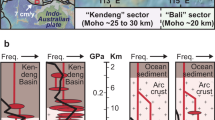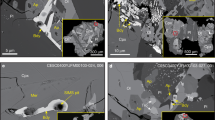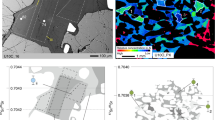Abstract
In southern Italy, there are several active volcanoes which occur in diverse geotectonic settings. Isotope determinations on coexisting minerals and whole-rocks from zero-age lavas from Vesuvius, Etna and Stromboli reveal an isotope equilibrium for Sr isotopes1 but not for Th (ref. 2). Analyses for Pb in the same samples also reveal differences in isotope composition, and in all cases the phenocrysts are less radiogenic than the whole-rocks. We argue here that the Pb and Th isotope composition of the magmas changed during and after fractional crystallization, possibly by crustal assimilation or by addition of mantle-derived fluids and that whole-rock Pb isotope data are not representative of the magma sources.
This is a preview of subscription content, access via your institution
Access options
Subscribe to this journal
Receive 51 print issues and online access
$199.00 per year
only $3.90 per issue
Buy this article
- Purchase on Springer Link
- Instant access to full article PDF
Prices may be subject to local taxes which are calculated during checkout
Similar content being viewed by others
References
Cortini, M. & Hermes, O. D. Contr. Miner. Petrol. 77, 47–55 (1981).
Capaldi, G., Cortini, M. & Pece, R. J. volcan. geotherm. Res. 14, 247–260 (1982).
Beccaluva, L., Rossi, P. L. & Serri, G. Earth Evol. Sci. 3, 222–238 (1982).
Hawkesworth, C. J. & Vollmer, R. Contr. Miner. Petrol. 69, 151–165 (1979).
Hermes, O. D. & Cornell, W. C. NSF Final Tech. Rep. (Univ. Rhode Island, 1978).
Vollmer, R. & Hawkesworth, C. J. Earth planet. Sci. Lett. 47, 91–101 (1980).
Carter, S. R. & Civetta, L. Earth planet. Sci. Lett. 36, 168–180 (1977).
Cortini, M. Bull. volca. 44–4, 711–722 (1981).
Vollmer, R. Geochim. cosmochim. Acta 40, 283–295 (1976).
Capaldi, G., Cortini, M. & Pece, R. Isotope Geosci. 1, 39–55 (1983).
Capaldi, G. & Pece, R. J. volcan. geotherm. Res. 11, 367–372 (1981).
Capaldi, G. et al. J. geophys. Res. 81, 350–358 (1976).
Barberi, F., Gasparini, P., Innocenti, F. & Villari, L. J. geophys. Res. 78, 5221–5232 (1973).
Vollmer, R., Johnston, K., Ghiara, M. R., Lirer, L. & Munno, R. J. volcan. geotherm. Res. 11, 317–327 (1981).
Di Girolamo, P. Bull. volcan. 41–3, 1–22 (1978).
Stacey, J. S. & Kramers, J. D. Earth planet. Sci. Lett. 26, 207–221.
Sun, S. S. Phil. Trans. R. Soc. A297, 409–445 (1980).
Author information
Authors and Affiliations
Rights and permissions
About this article
Cite this article
Cortini, M., Calsteren, P. Lead isotope differences between whole-rock and phenocrysts in recent lavas from southern Italy. Nature 314, 343–345 (1985). https://doi.org/10.1038/314343a0
Received:
Accepted:
Issue Date:
DOI: https://doi.org/10.1038/314343a0
This article is cited by
-
A mathematical model of trace element and isotopic behavior during simultaneous assimilation and imperfect fractional crystallization
Contributions to Mineralogy and Petrology (2012)
-
Compositional gradients in large reservoirs of silicic magma as evidenced by ignimbrites versus Taylor Creek Rhyolite lava domes
Contributions to Mineralogy and Petrology (1992)
-
Magma–cumulate mixing identified by U–Th disequilibrium dating
Nature (1988)
-
Mineralogical and isotopic evidence for phenocryst-matrix disequilibrium in the Garner Mountain andesite
Contributions to Mineralogy and Petrology (1988)
-
Isotope geochemistry: Contamination or source-region heterogeneity?
Nature (1985)
Comments
By submitting a comment you agree to abide by our Terms and Community Guidelines. If you find something abusive or that does not comply with our terms or guidelines please flag it as inappropriate.



